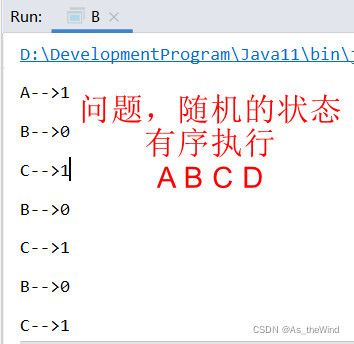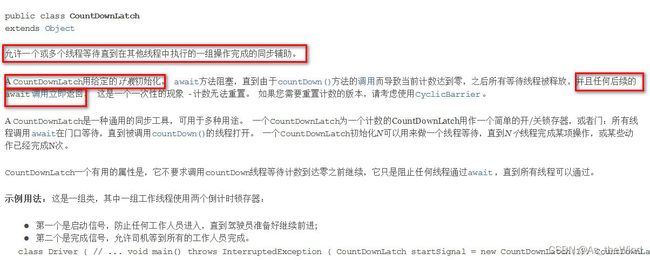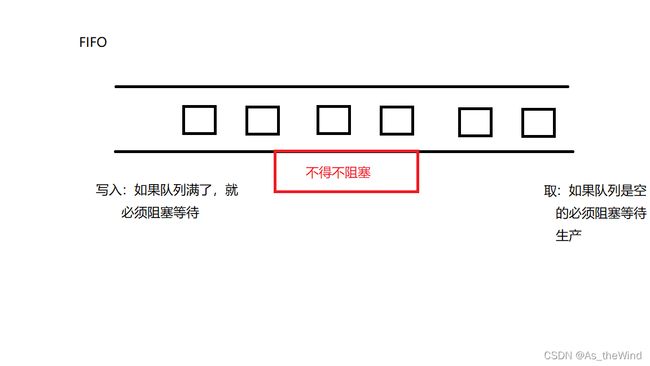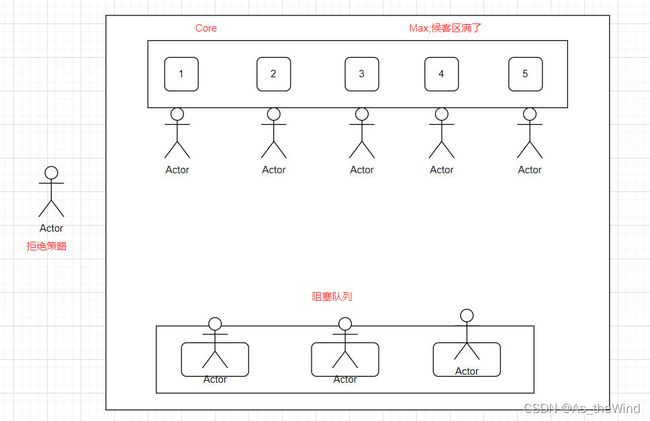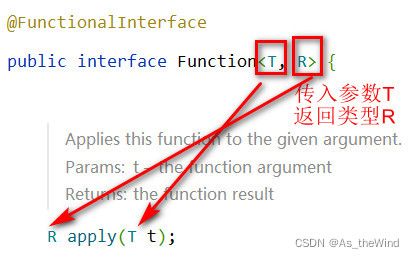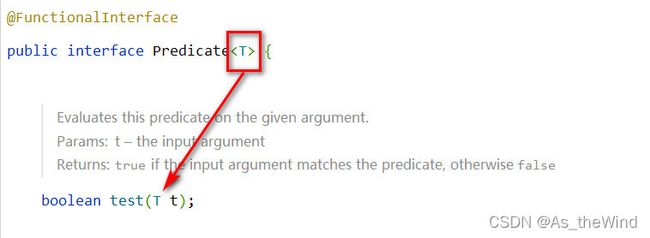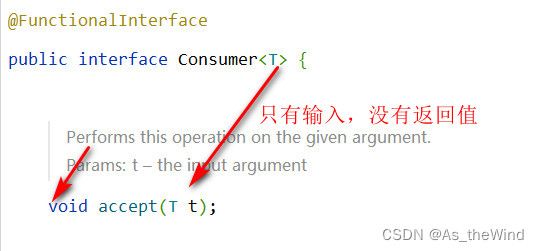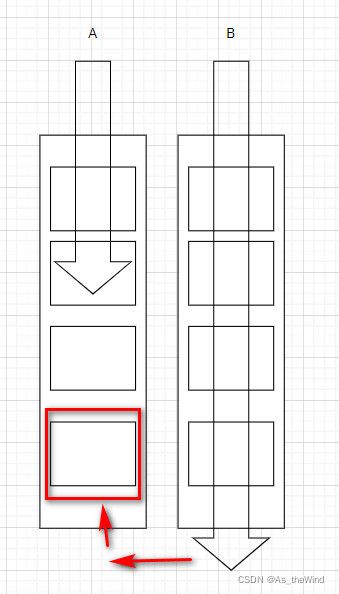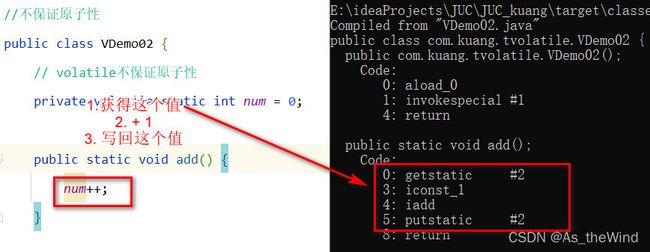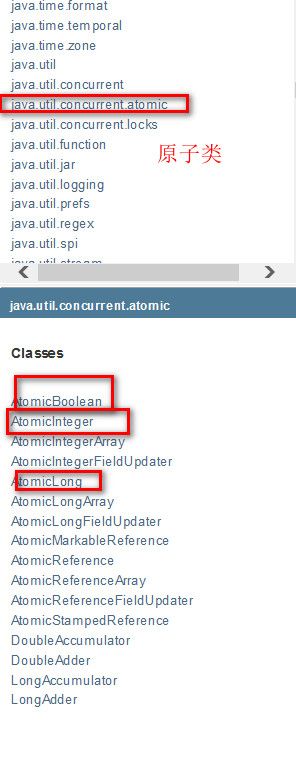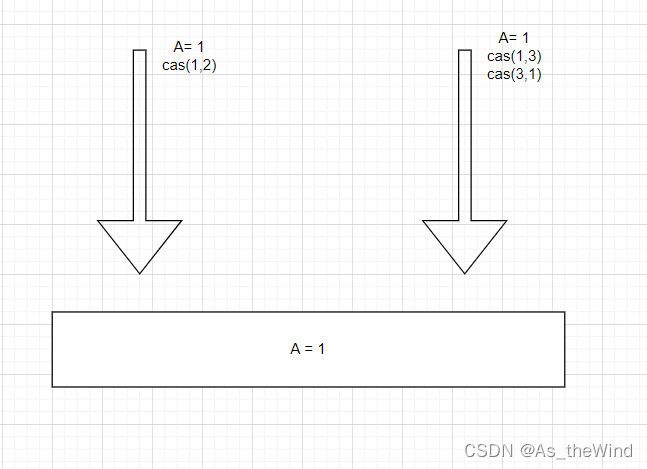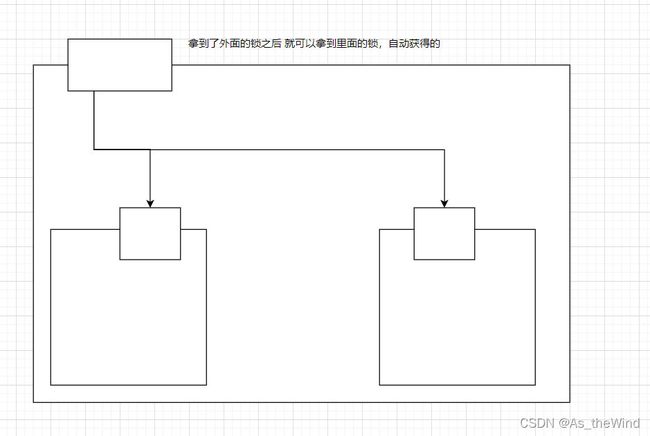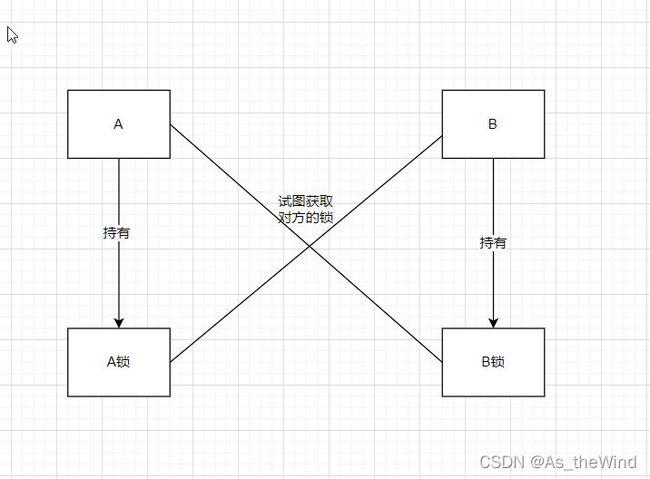狂神说JUC并发编程学习笔记
JUC
- 1.什么是JUC
- 2.线程和进程
- 3.Lock锁(重点)
-
- 传统Synchronized
- Lock接口
- Synchronized和Lock的区别
- 4.生产者和消费者问题
-
- 生产者和消费者问题Synchronized版
- 问题存在A,B,C,D四个线程
- JUC版的生产者和消费者问题
- Condition精准的通知和唤醒线程
- 八锁现象
- 6.集合类不安全
-
-
- List不安全
- Set不安全
- Map不安全
-
- 7.Callable(简单)
- 8.常用的辅助类(必会)
-
- 8.1 CountDownLatch
- 8.2 CyclicBarrier
- 8.3 Semaphore
- 9.读写锁
- 10.阻塞队列
- 10.SynchronousQueue同步队列
- 11.线程池(重点)
- 12、四大函数式接口(必须掌握)
- 13.Stream流式计算
- 14.ForkJoin
- 15.异步回调
- 16.JMM
- 17.Volatile
- 18.单例模式
- 19.深入理解CAS
- 20.原子引用
- 21.各种锁的理解
-
- 1.公平锁、非公平锁
- 2.可重入锁
- 3.自旋锁
- 4.死锁
1.什么是JUC
JUC 就是 java.util .concurrent 工具包的简称。这是一个处理线程的工具包,JDK1.5 开始出现的。
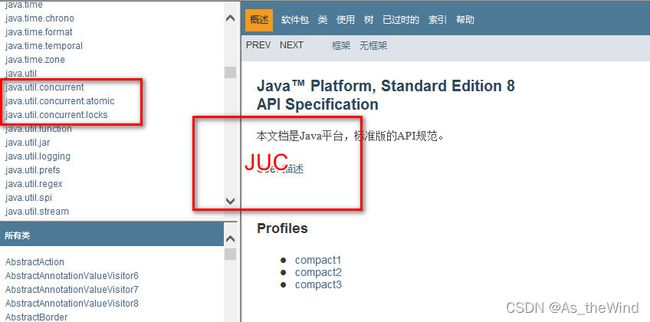
java.util工具包、包、分类
业务:普通的线程代码 Thread
Runnable 没有返回值、效率相比Callable相对较低!
2.线程和进程
进程:一个程序,比如QQ.ext Music.exe程序的集合。
一个进程往往可以包含多个线程,至少包含一个。
Java默认有两个线程,一个main,一个GC
线程:开了一个进程Typora,写字,自动保存(线程负责的)
对于Java而言:Thread、Runnable、Callable
Java真正是开不了线程的
public synchronized void start() {
/**
* This method is not invoked for the main method thread or "system"
* group threads created/set up by the VM. Any new functionality added
* to this method in the future may have to also be added to the VM.
*
* A zero status value corresponds to state "NEW".
*/
if (threadStatus != 0)
throw new IllegalThreadStateException();
/* Notify the group that this thread is about to be started
* so that it can be added to the group's list of threads
* and the group's unstarted count can be decremented. */
group.add(this);
boolean started = false;
try {
start0();
started = true;
} finally {
try {
if (!started) {
group.threadStartFailed(this);
}
} catch (Throwable ignore) {
/* do nothing. If start0 threw a Throwable then
it will be passed up the call stack */
}
}
}
//本地方法,底层的c++,java无法直接操作硬件
private native void start0();
并发和并行
并发(多线程操作同一个资源)
- CPU一核,模拟出来多条线程
并行(多个人一起行走) - CPU多核,多个线程可以同时执行;线程池
public class Test1 {
public static void main(String[] args) {
//获取CPU核数
//CPU密集型,IO密集型
System.out.println(Runtime.getRuntime().availableProcessors());
}
}
并发编程的本质:充分利用CPU的资源
线程的几个状态
public enum State {
// 线程新生
NEW,
//运行状态
RUNNABLE,
//阻塞
BLOCKED,
//等待,死死地等
WAITING,
//超时等待
TIMED_WAITING,
//终止
TERMINATED;
}
wait/sleep的区别
1.来自不同的类
wait -> Object
sleep -> Thread
2.锁的释放
wait会释放锁,sleep睡觉了,抱着锁睡觉,不会释放!
3.使用的范围不同
wait必须在同步代码块
sleep可以在任何地方睡
4.是否需要捕获异常
wait不需要捕获异常
sleep必须要捕获异常
3.Lock锁(重点)
传统Synchronized
//基本的卖票例子
/*
真正的多线程开发,公司中的开发,降低耦合性
线程就是一个单独的资源类,没有任何附属操作
1、属性、方法
*/
public class SaleTicketDemo1 {
public static void main(String[] args) {
//并发:多线程操作同一个类,把资源类丢入线程
Ticket ticket = new Ticket();
//@FunctionalInterface 函数式接口,jdk1.8 lambda表达式 (参数)->{代码}
new Thread( () ->{
for (int i = 0; i < 40; i++) {
ticket.sale();
}
},"A").start();
new Thread( () ->{
for (int i = 0; i < 40; i++) {
ticket.sale();
}
},"B").start();
new Thread( () ->{
for (int i = 0; i < 40; i++) {
ticket.sale();
}
},"C").start();
}
}
//资源类 OOP
class Ticket{
//属性方法
private int number = 50;
//卖票的方式
//synchronized 本质;队列、锁
public synchronized void sale(){
if(number > 0){
System.out.println(Thread.currentThread().getName() + "卖出了" + (number--) + "票,剩余" + number);
}
}
}
Lock接口



公平锁:十分公平:可以先来后到
非公平锁:十分不公平:可以插队(默认)
import java.util.concurrent.locks.Lock;
import java.util.concurrent.locks.ReentrantLock;
//基本的卖票例子
/*
真正的多线程开发,公司中的开发,降低耦合性
线程就是一个单独的资源类,没有任何附属操作
1、属性、方法
*/
public class SaleTicketDemo2 {
public static void main(String[] args) {
//并发:多线程操作同一个类,把资源类丢入线程
Ticket2 ticket = new Ticket2();
//@FunctionalInterface 函数式接口,jdk1.8 lambda表达式 (参数)->{代码}
new Thread( () ->{
for (int i = 0; i < 40; i++) {
ticket.sale();
}
},"A").start();
new Thread( () ->{
for (int i = 0; i < 40; i++) {
ticket.sale();
}
},"B").start();
new Thread( () ->{
for (int i = 0; i < 40; i++) {
ticket.sale();
}
},"C").start();
}
}
//Lock三部曲
//1.new ReentrantLock();
//2. lock.lock(); 加锁
//3.finally --> lock.unlock(); 解锁
class Ticket2{
//属性方法
private int number = 50;
Lock lock = new ReentrantLock();
public void sale(){
lock.lock(); //加锁
try{
//业务代码
if(number > 0){
System.out.println(Thread.currentThread().getName() + "卖出了" + (number--) + "票,剩余" + number);
}
}catch (Exception e){
e.printStackTrace();
}finally {
//解锁
lock.unlock();
}
}
}
Synchronized和Lock的区别
1、Synchronized内置的Java关键字,Lock是一个Java类
2、Synchronized无法判断获取锁的状态,Lock可以判断是否获取到了锁
3、Synchronized是全自动的,会自动释放锁,Lock必须要手动释放锁,如果不释放锁,死锁
4、Synchronized 线程1(获得锁,阻塞)、线程2(等待,傻傻的等);Lock锁就不一定会等待下去
5、Synchronized可重入锁,不可以中断,非公平;Lock可重入锁,可以判断锁,非公平(可以自己设置)
6、Synchronized适合锁少量的代码同步问题,Lock适合锁大量的同步代码
4.生产者和消费者问题
生产者和消费者问题Synchronized版
/**
* 线程之间的通信问题:生产者和消费者问题 等待唤醒,通知唤醒
* 线程交替执行 A B 操作同一个变量 num = 0
* A num + 1
* B num - 1
*/
public class A {
public static void main(String[] args) {
Data data = new Data();
new Thread(()->{
for (int i = 0; i < 100; i++) {
try {
data.increment();
} catch (InterruptedException e) {
e.printStackTrace();
}
}
},"A").start();
new Thread(()->{
for (int i = 0; i < 100; i++) {
try {
data.decrement();
} catch (InterruptedException e) {
e.printStackTrace();
}
}
},"B").start();
}
}
//判断等待,业务,通知
class Data{ // 数字 资源类
private int number = 0;
// + 1
public synchronized void increment() throws InterruptedException {
if(number != 0){
//等待
this.wait();
}
number ++;
System.out.println(Thread.currentThread().getName() + "-->" + number);
//通知其他线程,我+1完毕了
this.notifyAll();
}
// - 1
public synchronized void decrement() throws InterruptedException {
if(number == 0){
//等待
this.wait();
}
number --;
System.out.println(Thread.currentThread().getName() + "-->" + number);
//通知其他线程,我-1完毕了
this.notifyAll();
}
}
问题存在A,B,C,D四个线程
/**
* 线程之间的通信问题:生产者和消费者问题 等待唤醒,通知唤醒
* 线程交替执行 A B 操作同一个变量 num = 0
* A num + 1
* B num - 1
*/
public class A {
public static void main(String[] args) {
Data data = new Data();
new Thread(()->{
for (int i = 0; i < 100; i++) {
try {
data.increment();
} catch (InterruptedException e) {
e.printStackTrace();
}
}
},"A").start();
new Thread(()->{
for (int i = 0; i < 100; i++) {
try {
data.decrement();
} catch (InterruptedException e) {
e.printStackTrace();
}
}
},"B").start();
new Thread(()->{
for (int i = 0; i < 100; i++) {
try {
data.increment();
} catch (InterruptedException e) {
e.printStackTrace();
}
}
},"C").start();
new Thread(()->{
for (int i = 0; i < 100; i++) {
try {
data.decrement();
} catch (InterruptedException e) {
e.printStackTrace();
}
}
},"D").start();
}
}
//判断等待,业务,通知
class Data{ // 数字 资源类
private int number = 0;
// + 1
public synchronized void increment() throws InterruptedException {
while(number != 0){
//等待
this.wait();
}
number ++;
System.out.println(Thread.currentThread().getName() + "-->" + number);
//通知其他线程,我+1完毕了
this.notifyAll();
}
// - 1
public synchronized void decrement() throws InterruptedException {
while(number == 0){
//等待
this.wait();
}
number --;
System.out.println(Thread.currentThread().getName() + "-->" + number);
//通知其他线程,我-1完毕了
this.notifyAll();
}
}
JUC版的生产者和消费者问题
import java.util.concurrent.locks.Condition;
import java.util.concurrent.locks.Lock;
import java.util.concurrent.locks.ReentrantLock;
/**
* 线程之间的通信问题:生产者和消费者问题 等待唤醒,通知唤醒
* 线程交替执行 A B 操作同一个变量 num = 0
* A num + 1
* B num - 1
*/
public class B {
public static void main(String[] args) {
Data2 data = new Data2();
new Thread(()->{
for (int i = 0; i < 100; i++) {
try {
data.increment();
} catch (InterruptedException e) {
e.printStackTrace();
}
}
},"A").start();
new Thread(()->{
for (int i = 0; i < 100; i++) {
try {
data.decrement();
} catch (InterruptedException e) {
e.printStackTrace();
}
}
},"B").start();
new Thread(()->{
for (int i = 0; i < 100; i++) {
try {
data.increment();
} catch (InterruptedException e) {
e.printStackTrace();
}
}
},"C").start();
new Thread(()->{
for (int i = 0; i < 100; i++) {
try {
data.decrement();
} catch (InterruptedException e) {
e.printStackTrace();
}
}
},"D").start();
}
}
//判断等待,业务,通知
class Data2 { // 数字 资源类
private int number = 0;
Lock lock = new ReentrantLock();
Condition condition = lock.newCondition();
// + 1
public void increment() throws InterruptedException {
lock.lock();
try {
//业务代码
while (number != 0) {
//等待
condition.await();
}
number++;
System.out.println(Thread.currentThread().getName() + "-->" + number);
//通知其他线程,我+1完毕了
condition.signalAll();
} catch (Exception e) {
e.printStackTrace();
} finally {
lock.unlock();
}
}
// - 1
public synchronized void decrement() throws InterruptedException {
lock.lock();
try {
//业务代码
while (number == 0) {
//等待
condition.await();
}
number--;
System.out.println(Thread.currentThread().getName() + "-->" + number);
//通知其他线程,我-1完毕了
condition.signalAll();
} catch (Exception e) {
e.printStackTrace();
} finally {
lock.unlock(); //解锁
}
}
}
Condition精准的通知和唤醒线程
/**
* A执行完调用B,B执行完调用C,C执行完调用A
*/
import java.util.concurrent.locks.Condition;
import java.util.concurrent.locks.Lock;
import java.util.concurrent.locks.ReentrantLock;
public class C {
public static void main(String[] args) {
Data3 data = new Data3();
new Thread(() -> {
for (int i = 0; i < 10; i++) {
data.printA();
}
}, "A").start();
new Thread(() -> {
for (int i = 0; i < 10; i++) {
data.printB();
}
}, "B").start();
new Thread(() -> {
for (int i = 0; i < 10; i++) {
data.printC();
}
}, "C").start();
}
}
class Data3 { //资源类 Lock
private Lock lock = new ReentrantLock();
private Condition condition1 = lock.newCondition();
private Condition condition2 = lock.newCondition();
private Condition condition3 = lock.newCondition();
private int number = 1; // 1A 2B 3C
public void printA() {
lock.lock();
try {
//业务代码,判单 -》 执行 -》 通知
while (number != 1) {
//等待
condition1.await();
}
System.out.println(Thread.currentThread().getName() + "=>AAAA");
//唤醒指定的人,B
number = 2;
condition2.signal();
} catch (Exception e) {
e.printStackTrace();
} finally {
//解锁
lock.unlock();
}
}
public void printB() {
lock.lock();
try {
//业务代码,判单 -》 执行 -》 通知
while (number != 2) {
condition2.await();
}
System.out.println(Thread.currentThread().getName() + "=>BBBB");
//唤醒,唤醒指定的人,C
number = 3;
condition3.signal();
} catch (Exception e) {
e.printStackTrace();
} finally {
//解锁
lock.unlock();
}
}
public void printC() {
lock.lock();
try {
//业务代码,判单 -》 执行 -》 通知
while (number != 3) {
condition3.await();
}
System.out.println(Thread.currentThread().getName() + "=>CCCC");
//唤醒,唤醒指定的人,C
number = 1;
condition1.signal();
} catch (Exception e) {
e.printStackTrace();
} finally {
//解锁
lock.unlock();
}
}
}
八锁现象
import java.util.concurrent.TimeUnit;
/**
* 八锁,就是关于锁的八个问题
* 1.标准情况下,两个线程先打印发短信 还是打电话 1/发短信 2/打电话
*/
public class Test1 {
public static void main(String[] args) {
Phone phone = new Phone();
//锁的问题
new Thread(() -> {
phone.send();
}, "A").start();
try {
TimeUnit.SECONDS.sleep(1);
} catch (InterruptedException e) {
e.printStackTrace();
}
new Thread(() -> {
phone.call();
}, "A").start();
}
}
class Phone {
//synchronized 锁的对象是方法的调用者
//两个方法用的是同一个锁,谁先拿到谁执行!
public synchronized void send() {
try {
TimeUnit.SECONDS.sleep(4);
} catch (InterruptedException e) {
e.printStackTrace();
}
System.out.println("发短信");
}
public synchronized void call() {
System.out.println("打电话");
}
}
import java.util.concurrent.TimeUnit;
/**
* 3.增加了一个普通方法 先执行发短信还是hello 普通方法
* 4.两个对象都是同步方法,先发短信还是打电话
*/
public class Test2 {
public static void main(String[] args) {
//两个对象,两个调用者,两把锁
Phone2 phone1 = new Phone2();
Phone2 phone2 = new Phone2();
//锁的问题
new Thread(() -> {
phone1.send();
}, "A").start();
try {
TimeUnit.SECONDS.sleep(1);
} catch (InterruptedException e) {
e.printStackTrace();
}
new Thread(() -> {
phone2.call();
}, "A").start();
}
}
class Phone2 {
//synchronized 锁的对象是方法的调用者
public synchronized void send() {
try {
TimeUnit.SECONDS.sleep(4);
} catch (InterruptedException e) {
e.printStackTrace();
}
System.out.println("发短信");
}
//这里没有锁!不是同步方法,不受锁的影响
public void hello() {
System.out.println("hello");
}
public synchronized void call() {
System.out.println("打电话");
}
}
import java.util.concurrent.TimeUnit;
/**
* 5.增加两个静态的同步方法,只有一个对象 先打印 发短信 打电话
* 5.两个对象! 增加两个静态的同步方法,先打印 发短信 打电话
*/
public class Test3 {
public static void main(String[] args) {
//两个对象的class类模板只有一个 static 锁的是class
Phone3 phone1 = new Phone3();
Phone3 phone2 = new Phone3();
//锁的问题
new Thread(() -> {
phone1.send();
}, "A").start();
try {
TimeUnit.SECONDS.sleep(1);
} catch (InterruptedException e) {
e.printStackTrace();
}
new Thread(() -> {
phone2.call();
}, "A").start();
}
}
class Phone3 {
//synchronized 锁的对象是方法的调用者
//static静态方法
//类一加载就有了!class模板
public static synchronized void send() {
try {
TimeUnit.SECONDS.sleep(4);
} catch (InterruptedException e) {
e.printStackTrace();
}
System.out.println("发短信");
}
//这里没有锁!不是同步方法,不受锁的影响
public void hello() {
System.out.println("hello");
}
public static synchronized void call() {
System.out.println("打电话");
}
}
import java.util.concurrent.TimeUnit;
/**
* 1. 1个静态的同步方法,1个普通的同步方法,一个对象,先打印 发短信 ? 打电话?
* 1. 1个静态的同步方法,1个普通的同步方法,二个对象,先打印 发短信 ? 打电话?
*/
public class Test4 {
public static void main(String[] args) {
//两个对象的class类模板只有一个 static 锁的是class
Phone4 phone1 = new Phone4();
Phone4 phone2 = new Phone4();
//锁的问题
new Thread(() -> {
phone1.send();
}, "A").start();
try {
TimeUnit.SECONDS.sleep(1);
} catch (InterruptedException e) {
e.printStackTrace();
}
new Thread(() -> {
phone2.call();
}, "A").start();
}
}
class Phone4 {
//静态同步方法 锁的是class类模板
public static synchronized void send() {
try {
TimeUnit.SECONDS.sleep(4);
} catch (InterruptedException e) {
e.printStackTrace();
}
System.out.println("发短信");
}
//普通的同步方法 锁的调用者
public synchronized void call() {
System.out.println("打电话");
}
}
小结
new this 具体的一个手机
static Class唯一的一个模板
6.集合类不安全
List不安全
import java.util.*;
import java.util.concurrent.CopyOnWriteArrayList;
//java.util.ConcurrentModificationException 并发修改异常
public class ListTest {
public static void main(String[] args) {
//并发下ArrayList不安全的
/**
* 解决方案:
* 1. List list = new Vector<>();
* 2.List list = Collections.synchronizedList(new ArrayList<>());
* 3.List list = new CopyOnWriteArrayList<>();
*/
//CopyOnWrite写入时复制 COW 计算机程序设计领域的一种优化策略
//多个线程调用的时候,list读取的时候,固定的,写入(覆盖)
//在写入的时候避免覆盖造成数据问题
//读写分离
//CopyOnWriteArrayList 比Vector 好在哪里?
List<String> list = new CopyOnWriteArrayList<>();
for (int i = 1; i <= 10; i++) {
new Thread(() -> {
list.add(UUID.randomUUID().toString().substring(0, 5));
System.out.println(list);
}, String.valueOf(i)).start();
}
}
}
Set不安全
import java.util.Collections;
import java.util.HashSet;
import java.util.Set;
import java.util.UUID;
import java.util.concurrent.CopyOnWriteArraySet;
//同理可证
public class SetTest {
public static void main(String[] args) {
//Set set = new HashSet<>();
//Set set = Collections.synchronizedSet(new HashSet<>());
Set<String> set = new CopyOnWriteArraySet<>();
for (int i = 1; i <= 50; i++) {
new Thread(() -> {
set.add(UUID.randomUUID().toString().substring(0, 5));
System.out.println(set);
}, String.valueOf(i)).start();
}
}
}
HashSet的底层实现
public HashSet(){
map = new HashMap<>();
}
//add Set本质就是 map Key是无法重复的
public boolean add(E e){
return map.put(e,PRESENT) == null;
}
private static final Object PRESENT = new Object(); //不变得值!
Map不安全
import java.util.Map;
import java.util.UUID;
import java.util.concurrent.ConcurrentHashMap;
//ConcurrentModificationException
public class MapTest {
public static void main(String[] args) {
//map是这样用的吗 不是,工作中不用HashMap
// 默认等价于什么 new HashMap<>(16,0.75);
//Map map = new HashMap<>();
Map<String, String> map = new ConcurrentHashMap<>();
//加载因子 、初始化容量
for (int i = 1; i <= 30; i++) {
new Thread(() -> {
map.put(Thread.currentThread().getName(), UUID.randomUUID().toString().substring(0, 5));
System.out.println(map);
}, String.valueOf(i)).start();
}
}
}
7.Callable(简单)

1.可以有返回值
2.可以抛出异常
3.方法不同,run() / call()
import java.util.concurrent.Callable;
import java.util.concurrent.ExecutionException;
import java.util.concurrent.FutureTask;
public class CallableTest {
public static void main(String[] args) throws ExecutionException, InterruptedException {
//new Thread(new Thread()).start();
//new Thread(new FutureTask()).start(); //怎么启动callable
new Thread().start(); //怎么启动callable
MyThread thread = new MyThread();
FutureTask futureTask = new FutureTask(thread); //适配类
new Thread(futureTask, "A").start();
String o = (String)futureTask.get();//获取Callable的返回结果
System.out.println(o);
}
}
class MyThread implements Callable<String> {
@Override
public String call() {
System.out.println("call()");
return "123";
}
}
细节:
1、有缓存
2、结果可能需要等待会阻塞!
8.常用的辅助类(必会)
8.1 CountDownLatch
import java.util.concurrent.CountDownLatch;
//计数器
public class CountDownLatchDemo {
public static void main(String[] args) throws InterruptedException {
//总数是6,必须要执行任务的时候,再使用!
CountDownLatch countDownLatch = new CountDownLatch(6);
for (int i = 1; i <= 6; i++) {
new Thread(() -> {
System.out.println(Thread.currentThread().getName() + "Go out");
countDownLatch.countDown(); //数量 -1
}, String.valueOf(i)).start();
}
countDownLatch.await();//等待计数器归0,然后再向下执行
System.out.println("close door");
}
}
原理:
countDownLatch.countDown(); //数量 -1
countDownLatch.await(); //等待计数器归0,然后再向下执行
每次有线程调用countDown()数量-1,假设计数器变为0,countDownLatch.await()就会被唤醒,继续执行!
8.2 CyclicBarrier
import java.util.concurrent.BrokenBarrierException;
import java.util.concurrent.CyclicBarrier;
public class CyclicBarrierDemo {
public static void main(String[] args) {
/**
* 集齐7颗龙珠召唤神龙
*/
//召唤龙珠的线程
CyclicBarrier cyclicBarrier = new CyclicBarrier(7, () -> {
System.out.println("召唤神龙成功!");
});
for (int i = 1; i <= 7; i++) {
final int temp = i;
//lambda能操作到i吗
new Thread(() -> {
System.out.println(Thread.currentThread().getName() + "收集" + temp + "个龙珠");
try {
cyclicBarrier.await(); //等待计数器变成7
} catch (InterruptedException e) {
e.printStackTrace();
} catch (BrokenBarrierException e) {
e.printStackTrace();
}
}).start();
}
}
}
8.3 Semaphore
import java.util.concurrent.Semaphore;
import java.util.concurrent.TimeUnit;
public class SemaphoreDemo {
public static void main(String[] args) {
//线程数量:停车位! 限流!
Semaphore semaphore = new Semaphore(3);
for (int i = 1; i <= 6; i++) {
new Thread(() -> {
// acquire() 得到
try {
semaphore.acquire();
System.out.println(Thread.currentThread().getName() + "抢到车位");
TimeUnit.SECONDS.sleep(2);
System.out.println(Thread.currentThread().getName() + "离开车位");
} catch (InterruptedException e) {
e.printStackTrace();
} finally {
semaphore.release();
}
// releas() 释放
},String.valueOf(i)).start();
}
}
}
原理:
semaphore.acquire();获得,假设如果已经满了,等待被释放为止!
semaphore.release();释放,会将当前的信号量释放+1,然后唤醒等待的线程!
作用:多个共享资源互斥的使用!并发限流,控制最大的线程数
9.读写锁
import java.util.HashMap;
import java.util.Map;
import java.util.concurrent.locks.Lock;
import java.util.concurrent.locks.ReentrantLock;
import java.util.concurrent.locks.ReentrantReadWriteLock;
/**
* 独占锁(写锁) 一次只能被一个线程占有
* 共享锁(读锁) 多个线程可以同时占有
* ReadWriteLock
* 读 - 读 可以共存
* 读 - 写 可以共存
* 写 - 写 不能共存
*/
public class ReadWriteLock {
public static void main(String[] args) {
MyCacheLock myCache = new MyCacheLock();
//只写入
for (int i = 1; i <= 5; i++) {
final int temp = i;
new Thread(() -> {
myCache.put(temp + "", temp + "");
}, String.valueOf(i)).start();
}
//读取
for (int i = 1; i <= 5; i++) {
final int temp = i;
new Thread(() -> {
myCache.get(temp + "");
}, String.valueOf(i)).start();
}
}
}
/**
* 自定义缓存
*/
class MyCache {
private volatile Map<String, Object> map = new HashMap<>();
// 存,写
public void put(String key, Object value) {
System.out.println(Thread.currentThread().getName() + "写入" + key);
map.put(key, value);
System.out.println(Thread.currentThread().getName() + "写入OK");
}
// 取,读
public void get(String key) {
System.out.println(Thread.currentThread().getName() + "读取" + key);
Object o = map.get(key);
System.out.println(Thread.currentThread().getName() + "读取OK");
}
}
//加锁的
class MyCacheLock {
private volatile Map<String, Object> map = new HashMap<>();
//读写锁 :更下细粒度的控制
private ReentrantReadWriteLock readWriteLock = new ReentrantReadWriteLock();
// 存,写入的时候,只希望同时只有一个线程写
public void put(String key, Object value) {
readWriteLock.writeLock().lock();
try {
System.out.println(Thread.currentThread().getName() + "写入" + key);
map.put(key, value);
System.out.println(Thread.currentThread().getName() + "写入OK");
} catch (Exception e) {
e.printStackTrace();
} finally {
readWriteLock.writeLock().unlock();
}
}
// 取,读,所有人都可以取读
public void get(String key) {
readWriteLock.readLock().lock();
try {
System.out.println(Thread.currentThread().getName() + "读取" + key);
Object o = map.get(key);
System.out.println(Thread.currentThread().getName() + "读取OK");
} catch (Exception e) {
e.printStackTrace();
} finally {
readWriteLock.readLock().unlock();
}
}
}
10.阻塞队列
BlockingQueue BlockingQueue 不是新的东西

什么情况下会使用阻塞队列:多线程并发处理,线程池!
使用队列
添加、移除
四组API
| 方式 | 抛出异常 | 有返回值,不抛出异常 | 阻塞等待 | 超时等待 |
|---|---|---|---|---|
| 添加 | add | offer() | put() | offer( , ,) |
| 删除 | remove | poll() | take() | poll( , ) |
| 检测队首元素 | element | peek() |
/**
* 抛出异常
*/
public static void test1() {
//队列的大小
ArrayBlockingQueue blockingQueue = new ArrayBlockingQueue<>(3);
System.out.println(blockingQueue.add("a"));
System.out.println(blockingQueue.add("b"));
System.out.println(blockingQueue.add("c"));
System.out.println("==========");
//IllegalStateException: Queue full 抛出异常!
//System.out.println(blockingQueue.add("d"));
System.out.println(blockingQueue.remove());
System.out.println(blockingQueue.remove());
System.out.println(blockingQueue.remove());
//java.util.NoSuchElementException 抛出异常!
//System.out.println(blockingQueue.remove());
}
/**
* 有返回值,没有异常
*/
public static void test2() {
//队列大小
ArrayBlockingQueue blockingQueue = new ArrayBlockingQueue<>(3);
System.out.println(blockingQueue.offer("a"));
System.out.println(blockingQueue.offer("b"));
System.out.println(blockingQueue.offer("c"));
//System.out.println(blockingQueue.offer("c")); //不抛出异常 false
System.out.println(blockingQueue.peek());
System.out.println("===============");
System.out.println(blockingQueue.poll());
System.out.println(blockingQueue.poll());
System.out.println(blockingQueue.poll());
System.out.println(blockingQueue.poll()); //不抛出异常 null
}
/**
* 等待,阻塞(一直阻塞)
*/
public static void test3() throws InterruptedException {
//队列的大小
ArrayBlockingQueue blockingQueue = new ArrayBlockingQueue(3);
//一直阻塞
blockingQueue.put("a");
blockingQueue.put("b");
blockingQueue.put("c");
//blockingQueue.put("d"); //队列没有位置了 ,一直阻塞
System.out.println(blockingQueue.take());
System.out.println(blockingQueue.take());
System.out.println(blockingQueue.take());
System.out.println(blockingQueue.take()); //没有这个元素 ,一直阻塞
}
10.SynchronousQueue同步队列
没有容量
进去一个元素,必须等待取出来之后,才能再往里面放入一个元素!
put、take
import java.util.concurrent.BlockingQueue;
import java.util.concurrent.SynchronousQueue;
import java.util.concurrent.TimeUnit;
/**
* 同步队列
* 和其他的BlockQueue不一样 SynchronousQueue 不存储元素
* put 了一个元素,必须先从里面take取出来,否则不能put进去值
*/
public class SynchronousQueueDemo {
public static void main(String[] args) {
BlockingQueue<String> blockingQueue = new SynchronousQueue<>();//同步队列
new Thread(() -> {
try {
System.out.println(Thread.currentThread().getName() + " put 1");
blockingQueue.put("1");
System.out.println(Thread.currentThread().getName() + " put 2");
blockingQueue.put("2");
System.out.println(Thread.currentThread().getName() + " put 3");
blockingQueue.put("3");
} catch (InterruptedException e) {
e.printStackTrace();
}
}, "T1").start();
new Thread(() -> {
try {
TimeUnit.SECONDS.sleep(3);
System.out.println(Thread.currentThread().getName() + " => " + blockingQueue.take());
TimeUnit.SECONDS.sleep(3);
System.out.println(Thread.currentThread().getName() + " => " + blockingQueue.take());
TimeUnit.SECONDS.sleep(3);
System.out.println(Thread.currentThread().getName() + " => " + blockingQueue.take());
} catch (InterruptedException e) {
e.printStackTrace();
}
}, "T2").start();
}
}
11.线程池(重点)
线程池:三大方法、7大参数、4种拒绝策略
池化技术
程序的运行,本质:占用系统的资源!优化资源的使用! =.> 池化技术
线程池、连接池、内存池、对象池… 创建和销毁十分浪费资源
池化技术:事先准备好一些资源,有人要用,就来我这里拿,用完之后还给
线程池的好处:
1、降低资源的消耗
2、提高响应的速度
3、方便管理
线程复用、可以控制最大并发数、管理线程
线程池:三大方法
线程池:七大参数
源码分析
public static ExecutorService newSingleThreadExecutor() {
return new FinalizableDelegatedExecutorService
(new ThreadPoolExecutor(1, 1,
0L, TimeUnit.MILLISECONDS,
new LinkedBlockingQueue<Runnable>()));
}
public static ExecutorService newFixedThreadPool(int nThreads) {
return new ThreadPoolExecutor(nThreads, nThreads,
0L, TimeUnit.MILLISECONDS,
new LinkedBlockingQueue<Runnable>());
}
public static ExecutorService newCachedThreadPool() {
return new ThreadPoolExecutor(0, Integer.MAX_VALUE, //21亿 OOM
60L, TimeUnit.SECONDS,
new SynchronousQueue<Runnable>());
}
//本质: ThreadPoolExecutor()
public ThreadPoolExecutor(int corePoolSize, //核心线程池大小
int maximumPoolSize, //最大核心线程池大小
long keepAliveTime, //超时了没有人调用就会释放
TimeUnit unit, //超时单位
BlockingQueue<Runnable> workQueue, //阻塞队列
ThreadFactory threadFactory,//线程工厂:创建线程的,一般不用动
RejectedExecutionHandler handler//拒绝策略) {
if (corePoolSize < 0 ||
maximumPoolSize <= 0 ||
maximumPoolSize < corePoolSize ||
keepAliveTime < 0)
throw new IllegalArgumentException();
if (workQueue == null || threadFactory == null || handler == null)
throw new NullPointerException();
this.corePoolSize = corePoolSize;
this.maximumPoolSize = maximumPoolSize;
this.workQueue = workQueue;
this.keepAliveTime = unit.toNanos(keepAliveTime);
this.threadFactory = threadFactory;
this.handler = handler;
}
手动创建一个线程池
import java.util.concurrent.*;
//Executors 工具类 3大方法
/**
* new ThreadPoolExecutor.AbortPolicy()); //银行满了 还有人进来,不处理这个人的,并且抛出异常
* new ThreadPoolExecutor.CallerRunsPolicy()); //哪来的去哪里!
* new ThreadPoolExecutor.DiscardPolicy()); //队列满了,丢掉任务,不会抛出异常
* new ThreadPoolExecutor.DiscardOldestPolicy()); //队列满了,尝试和最早的竞争,也不会抛出异常
*/
public class Demo01 {
public static void main(String[] args) {
//自定义线程池!工作ThreadPoolExecutor
ExecutorService threadPool = new ThreadPoolExecutor(
2,
5,
3,
TimeUnit.SECONDS,
new LinkedBlockingQueue<>(3),
Executors.defaultThreadFactory(),
new ThreadPoolExecutor.DiscardOldestPolicy()); //队列满了,尝试和最早的竞争,也不会抛出异常
try {
//最大承载:Deque + max
// 超过 RejectedExecutionException
for (int i = 1; i <= 9; i++) {
//使用了线程池之后,使用线程池来创建线程
threadPool.execute(() -> {
System.out.println(Thread.currentThread().getName() + " ok");
});
}
} catch (Exception e) {
e.printStackTrace();
} finally {
//线程池用完,程序结束,关闭线程池
threadPool.shutdown();
}
}
}
四种拒绝策略
/**
* new ThreadPoolExecutor.AbortPolicy()); //银行满了 还有人进来,不处理这个人的,并且抛出异常
* new ThreadPoolExecutor.CallerRunsPolicy()); //哪来的去哪里!
* new ThreadPoolExecutor.DiscardPolicy()); //队列满了,丢掉任务,不会抛出异常
* new ThreadPoolExecutor.DiscardOldestPolicy()); //队列满了,尝试和最早的竞争,也不会抛出异常
*/
小结和拓展
池的最大的大小如何去设置
了解:IO密集型,CPU密集型:(调优)
import java.util.concurrent.*;
public class Demo01 {
public static void main(String[] args) {
//自定义线程池!工作ThreadPoolExecutor
//最大线程池该如何定义
//1、CPU密集型,几核CPU就定义为几 可以保证cpu的效率最高
//2、IO密集型 判断你程序中十分耗IO线程,
// 程序 15个大型任务 io十分占用资源!
//获取CPU核数
System.out.println(Runtime.getRuntime().availableProcessors());
ExecutorService threadPool = new ThreadPoolExecutor(
2,
Runtime.getRuntime().availableProcessors(),
3,
TimeUnit.SECONDS,
new LinkedBlockingQueue<>(3),
Executors.defaultThreadFactory(),
new ThreadPoolExecutor.DiscardOldestPolicy()); //队列满了,尝试和最早的竞争,也不会抛出异常
try {
//最大承载:Deque + max
// 超过 RejectedExecutionException
for (int i = 1; i <= 9; i++) {
//使用了线程池之后,使用线程池来创建线程
threadPool.execute(() -> {
System.out.println(Thread.currentThread().getName() + " ok");
});
}
} catch (Exception e) {
e.printStackTrace();
} finally {
//线程池用完,程序结束,关闭线程池
threadPool.shutdown();
}
}
}
12、四大函数式接口(必须掌握)
lambda表达式、链式编程、函数式接口、Stream流式计算
函数式接口:只有一个方法的接口
@FunctionalInterface
public interface Runnable {
public abstract void run();
}
//超级多FunctionalInterface
//简化编程模型,在新版本的框架底层大量应用!
//foreach(消费者类型的函数式接口)
import java.util.function.Function;
/**
* Function 函数型接口
* 有一个输入参数,有一个输出
* 只要是函数式接口 就可以用lambda表达式简化
*/
public class Demo01 {
public static void main(String[] args) {
/*Function function = new Function() {
@Override
public String apply(String str) {
return str;
}
};*/
Function<String, String> function = (str) -> {
return str;
};
System.out.println(function.apply("asd"));
}
}
断定型接口
import java.util.function.Predicate;
/**
* 断定型接口:有一个输入参数,返回值只能是布尔值!
*/
public class Demo02 {
public static void main(String[] args) {
/*Predicate predicate = new Predicate() {
//判断字符串是否为空
@Override
public boolean test(String str) {
return str.isEmpty();
}
};*/
Predicate<String> predicate = (str) -> {
return str.isEmpty();
};
System.out.println(predicate.test(""));
}
}
Consumer 消费型接口
import java.util.function.Consumer;
/**
* Consumer消费型接口:只有输入,没有返回值
*/
public class Demo03 {
public static void main(String[] args) {
/*Consumer consumer = new Consumer() {
@Override
public void accept(String s) {
System.out.println(s);
}
};*/
Consumer<String> consumer = (s) -> {
System.out.println(s);
};
consumer.accept("asd");
}
}
Supplier 供给型接口
import java.util.function.Supplier;
/**
* Supplier 供给型接口没有参数,只有返回值
*/
public class Demo04 {
public static void main(String[] args) {
/*Supplier supplier = new Supplier() {
@Override
public Integer get() {
System.out.println("get()");
return 1024;
}
};*/
Supplier supplier = () -> {
System.out.println("get()");
return 1024;
};
System.out.println(supplier.get());
}
}
13.Stream流式计算
什么是Stream流式计算
大数据:存储+计算
集合、MySQL本质就是存储东西的
计算都应该交给流操作
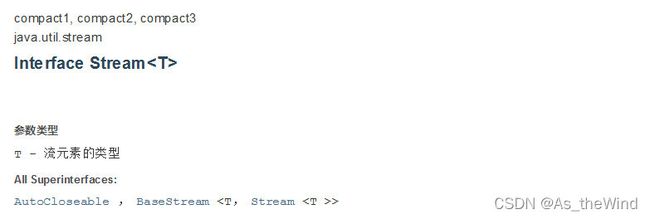
import java.util.Arrays;
import java.util.List;
/**
* 题目要求:一分钟内完成此题,只能用一行代码实现!
* 现在有5个用户!筛选:
* 1、ID必须是偶数
* 2、年龄必须大于23岁
* 3、用户名转为大写字母
* 4、用户名字母倒着排序
* 5、只输出一个用户!
*/
public class Test {
public static void main(String[] args) {
User u1 = new User(1, "a", 21);
User u2 = new User(2, "b", 22);
User u3 = new User(3, "c", 23);
User u4 = new User(4, "d", 24);
User u5 = new User(6, "e", 25);
//集合就是存储
List<User> list = Arrays.asList(u1, u2, u3, u4, u5);
//计算交给stream流
list.stream()
.filter(u -> {return u.getId() % 2 == 0;})
.filter(u -> {return u.getAge() > 23;})
.map(u -> {return u.getName().toUpperCase();})
.sorted((o1,o2)->{return o2.compareTo(o1);})
.limit(1)
.forEach(System.out::println);
}
}
14.ForkJoin
什么是ForkJoin
ForkJoin在JDK1.7,并行执行任务!提高效率。大数据量!
大数据:Map Reduce(把大人物拆分为小任务)
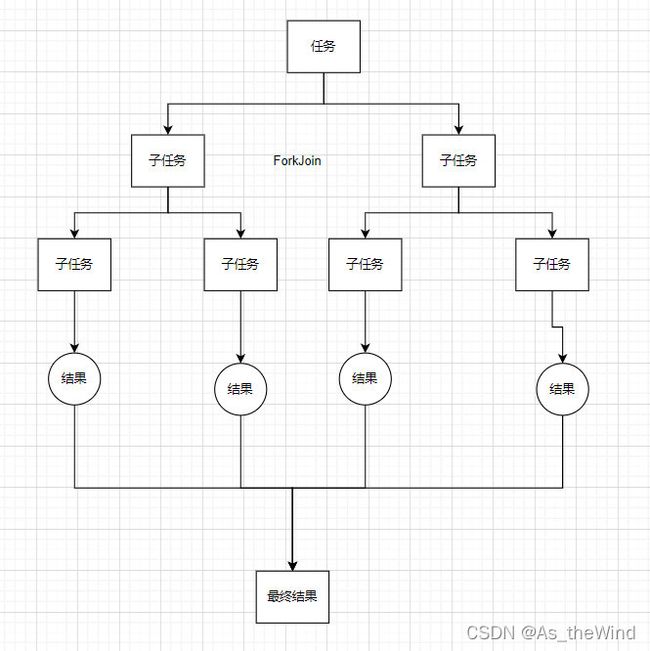
ForkJoin特点:工作窃取
ForkJoin
import java.util.concurrent.RecursiveTask;
//求和计算的任务
//如何使用forkJoin
//1、forkJoinPool通过它来执行
//2、计算任务 forkjoinPool.execute(ForkJoinTask task)
//3、计算类要继承ForkJoinTask
public class ForkJoinDemo extends RecursiveTask<Long> {
private Long start;
private Long end;
//临界值
private Long temp = 10000L;
public ForkJoinDemo(Long start, Long end) {
this.start = start; //1
this.end = end; //1990900000
}
//计算方法
@Override
protected Long compute() {
if ((end - start) < temp) {
Long sum = 0L;
for (Long i = start; i < end; i++) {
//分支合并计算
sum += i;
}
return sum;
} else { //forkJoin 递归
long mid = (start + end) / 2; //中间值
ForkJoinDemo task1 = new ForkJoinDemo(start, mid);
task1.fork(); //拆分任务,把任务压入线程队列
ForkJoinDemo task2 = new ForkJoinDemo(mid + 1, end);
task2.fork(); //拆分任务,把任务压入线程队列
return task1.join() + task2.join();
}
}
}
测试
import java.util.concurrent.ExecutionException;
import java.util.concurrent.ForkJoinPool;
import java.util.concurrent.ForkJoinTask;
import java.util.stream.LongStream;
//同一个任务效率高几十倍
public class Test {
public static void main(String[] args) throws ExecutionException, InterruptedException {
//test1();
//test2();
test3();
}
//普通
public static void test1() {
long start = System.currentTimeMillis();
Long sum = 0L;
for (Long i = 1L; i < 10_0000_0000; i++) {
sum += i;
}
long end = System.currentTimeMillis();
System.out.println("sum=" + sum + "时间:" + (end - start));
}
//会使用ForkJoin的
public static void test2() throws ExecutionException, InterruptedException {
long start = System.currentTimeMillis();
ForkJoinPool forkJoinPool = new ForkJoinPool();
ForkJoinTask<Long> task = new ForkJoinDemo(0L, 10_0000_0000L);
ForkJoinTask<Long> submit = forkJoinPool.submit(task);//提交任务
Long sum = submit.get();
long end = System.currentTimeMillis();
System.out.println("sum=" + sum + "时间:" + (end - start));
}
public static void test3() {
long start = System.currentTimeMillis();
//Stream并行流() (]
LongStream.rangeClosed(0L, 10_0000_0000L).parallel().reduce(0, Long::sum);
long end = System.currentTimeMillis();
System.out.println("sum=" + "时间:" + (end - start));
}
}
15.异步回调
Future设计的初衷:可以对将来的某个事件的结果进行建模
import java.util.concurrent.CompletableFuture;
import java.util.concurrent.ExecutionException;
import java.util.concurrent.Future;
import java.util.concurrent.TimeUnit;
/**
* 异步调用: CompletableFuture
* 异步执行
* 成功回调
* 失败回调
*/
public class Demo01 {
public static void main(String[] args) throws ExecutionException, InterruptedException {
//没有返回值的runAsync异步回调
/*CompletableFuture completableFuture = CompletableFuture.runAsync(() -> {
try {
TimeUnit.SECONDS.sleep(2);
} catch (InterruptedException e) {
e.printStackTrace();
}
System.out.println(Thread.currentThread().getName() + "runAsync = >Void");
});
System.out.println("11111");
completableFuture.get(); //获取执行结果*/
//有返回值的 异步回调
//ajax,成功和失败的回调
//返回的是错误信息:
CompletableFuture<Integer> completableFuture = CompletableFuture.supplyAsync(() -> {
System.out.println("CompletableFuture");
int i = 10/0;
return 1024;
});
System.out.println(completableFuture.whenComplete((t, u) -> {
System.out.println("t==>" + t); //正常的返回结果
System.out.println("u==>" + u); //错误的信息,java.util.concurrent.CompletionException: java.lang.ArithmeticException: / by zero
}).exceptionally((e) -> {
System.out.println(e.getMessage());
return 233; //可以获取到错误的返回结果
}).get());
/**
* success Code 200
* error Code 404 500
*/
}
}
16.JMM
对Volatile的理解
Volatile是Java虚拟机提供轻量级的同步机制
1.保证可见性
2.不保证原子性
3.禁止指令重排
什么是JMM
JMM :Java内存模型,不存在的东西,概念!约定!
关于JMM的一些同步的约定:
1、线程解锁前,必须把共享变量立刻刷回主存。
2、线程加锁前,必须读取主存中的最新值到工作内存中。
3、加锁和解锁是同一把锁
线程工作内存、主内存
8种操作
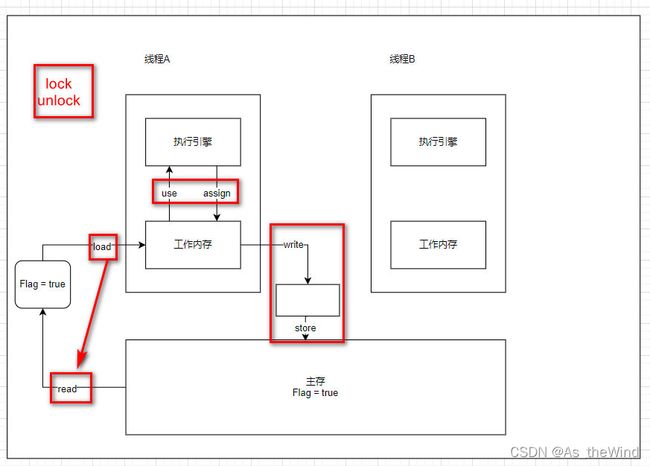
内存交互操作有8种,虚拟机实现必须保证每一个操作都是原子的,不可在分的(对于double和long类型的变量来说,load、store、read和write操作在某些平台上允许例外)
- lock (锁定):作用于主内存的变量,把一个变量标识为线程独占状态
- unlock (解锁):作用于主内存的变量,它把一个处于锁定状态的变量释放出来,释放后的变量才可以被其他线程锁定
- read (读取):作用于主内存变量,它把一个变量的值从主内存传输到线程的工作内存中,以便随后的load动作使用
- load (载入):作用于工作内存的变量,它把read操作从主存中变量放入工作内存中
- use (使用):作用于工作内存中的变量,它把工作内存中的变量传输给执行引擎,每当虚拟机遇到一个需要使用到变量的值,就会使用到这个指令
- assign (赋值):作用于工作内存中的变量,它把一个从执行引擎中接受到的值放入工作内存的变量副本中
- store (存储):作用于主内存中的变量,它把一个从工作内存中一个变量的值传送到主内存中,以便后续的write使用
- write (写入):作用于主内存中的变量,它把store操作从工作内存中得到的变量的值放入主内存的变量中
JMM对这八种指令的使用,制定了如下规则:
- 不允许read和load、store和write操作之一单独出现。即使用了read必须load,使用了store必须write
- 不允许线程丢弃他最近的assign操作,即工作变量的数据改变了之后,必须告知主存
- 不允许一个线程将没有assign的数据从工作内存同步回主内存
- 一个新的变量必须在主内存中诞生,不允许工作内存直接使用一个未被初始化的变量。就是怼变量实施use、store操作之前,必须经过assign和load操作
- 一个变量同一时间只有一个线程能对其进行lock。多次lock后,必须执行相同次数的unlock才能解锁
- 如果对一个变量进行lock操作,会清空所有工作内存中此变量的值,在执行引擎使用这个变量前,必须重新load或assign操作初始化变量的值
- 如果一个变量没有被lock,就不能对其进行unlock操作。也不能unlock一个被其他线程锁住的变量
- 对一个变量进行unlock操作之前,必须把此变量同步回主内存
17.Volatile
1、保证可见性
import java.util.concurrent.TimeUnit;
public class JMMDemo {
//不加 volatile 程序就会死循环!
// 加了volatile可以保证可见性
private volatile static int num = 0;
public static void main(String[] args) { //main线程
new Thread(() -> { //线程1 对主内存的变化是不知道的
while (num == 0) {
}
}).start();
try {
TimeUnit.SECONDS.sleep(1);
} catch (InterruptedException e) {
e.printStackTrace();
}
num = 1;
System.out.println(num);
}
}
2、不保原子性
原子性:不可分割
线程A在执行任务的时候,不能被打扰的,也不能被分割。要么同时成功要么同时失败。
//不保证原子性
public class VDemo02 {
// volatile不保证原子性
private volatile static int num = 0;
public static void add() {
num++; // 不是原子性操作
}
public static void main(String[] args) {
//理论上num结果为两万
for (int i = 0; i < 20; i++) {
new Thread(() -> {
for (int j = 0; j < 1000; j++) {
add();
}
}).start();
}
while (Thread.activeCount() > 2) { //main jc
Thread.yield();
}
System.out.println(Thread.currentThread().getName() + " " + num);
}
}
如果不加lock和synchronized,怎么样保证原子性
原子类为什么这么高级
import java.util.concurrent.atomic.AtomicInteger;
//不保证原子性
public class VDemo02 {
// volatile不保证原子性
//原子类的
private volatile static AtomicInteger num = new AtomicInteger();
public static void add() {
// num++;
num.getAndIncrement(); // AtomicInteger + 1 方法,CAS
}
public static void main(String[] args) {
//理论上num结果为两万
for (int i = 0; i < 20; i++) {
new Thread(() -> {
for (int j = 0; j < 1000; j++) {
add();
}
}).start();
}
while (Thread.activeCount() > 2) { //main jc
Thread.yield();
}
System.out.println(Thread.currentThread().getName() + " " + num);
}
}
这些类的底层都直接和操作系统挂钩!在内存中修改值 ! Unsafe类是一个很特殊的存在!
指令重排
什么是指令重排:你写的程序,计算机并不是按照你写的那样去执行的。
源代码 --> 编译器优化的重排–> 指令并行也可能回重排–> 内存系统也会重排–>执行
处理器在进行指令重排的时候会考虑一个问题,考虑:数据之间的依赖性!
int x = 1; //1
int y = 2; //2
x = x + 5; //3
y = x * x; //4
我们所期望的:1234 但是可能执行的时候会变成 2134 1324
可不可能是 4123!
可能造成影响的结果: a b x y 这四个值默认都是0;
| 线程A | 线程B |
|---|---|
| x = a | y = b |
| b = 1 | a = 2 |
正常的结果:x = 0; y = 0;
| 线程A | 线程B |
|---|---|
| b = 1 | a = 2 |
| x = a | y = b |
指令重排导致的诡异的结果:x = 2; y = 1;
volatile可以避免指令重排:
内存屏障,CPU指令,作用:
1、保证特定的操作的执行顺序!
2、可以保证某些变量的内存可见性(利用这些特性volatile实现了可见性)
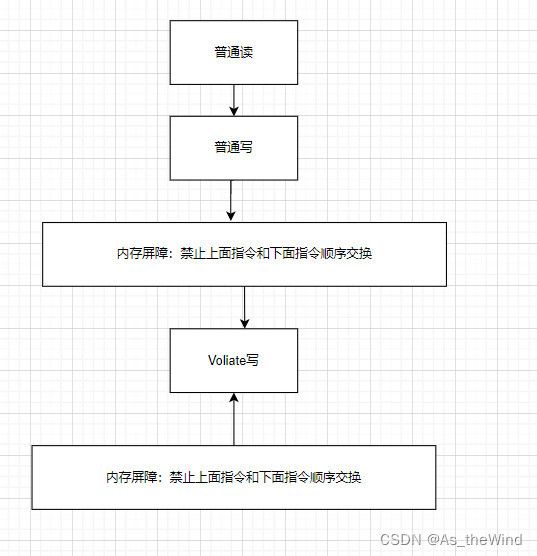
Volatile是可以保证可见性。不能保证原子性,由于内存屏障,可以保证避免指令重排的现象产生!
18.单例模式
饿汉式 DCL懒汉式
饿汉式
//饿汉式单例
public class Hungry {
//可能会浪费空间
private byte[] data1 = new byte[1024 * 1024];
private byte[] data2 = new byte[1024 * 1024];
private byte[] data3 = new byte[1024 * 1024];
private byte[] data4 = new byte[1024 * 1024];
private Hungry() {
}
private final static Hungry HUNGRY = new Hungry();
public static Hungry getInstance() {
return HUNGRY;
}
}
DCL懒汉式
import java.lang.reflect.Constructor;
import java.lang.reflect.Field;
//懒汉式单例模式
public class LazyMan {
private static boolean qinjiang = false;
private LazyMan() {
synchronized (LazyMan.class) {
if (qinjiang == false) {
qinjiang = true;
} else {
throw new RuntimeException("不要试图使用反射破坏异常");
}
}
System.out.println(Thread.currentThread().getName() + "OK");
}
private static LazyMan lazyMan;
//双重检测锁模式的懒汉式单例 简称DCL懒汉式
public static LazyMan getInstance() {
if (lazyMan == null) {
synchronized (LazyMan.class) {
if (lazyMan == null) {
lazyMan = new LazyMan(); //不是一个原子性操作
}
}
}
return lazyMan;
}
/**
* 1.分配内存空间
* 2.执行构造方法,初始化对象
* 3.把这个对象指向这个空间
*
* 期望 123
* 执行 132 A
* B //此时lazyMan还没有完成构造
*/
静态内部类
//静态内部类
public class Holder {
private Holder() {
}
public static Holder getInstance() {
return InnerClass.HOLDER;
}
public static class InnerClass {
private static final Holder HOLDER = new Holder();
}
}
单例不安全,因为有反射
枚举
//enum 是一个什么?本身也是一个Class类
public enum EnumSingle {
INSTANCE;
public EnumSingle getInstance() {
return INSTANCE;
}
}
class Test {
public static void main(String[] args) throws NoSuchMethodException, InvocationTargetException, InstantiationException, IllegalAccessException {
EnumSingle instance1 = EnumSingle.INSTANCE;
Constructor<EnumSingle> declaredConstructor = EnumSingle.class.getDeclaredConstructor(String.class, int.class);
declaredConstructor.setAccessible(true);
EnumSingle instance2 = declaredConstructor.newInstance();
// NoSuchMethodException: com.kuang.single.EnumSingle.()
System.out.println(instance1);
System.out.println(instance2);
}
}
public final class EnumSingle extends Enum
{
public static EnumSingle[] values()
{
return (EnumSingle[])$VALUES.clone();
}
public static EnumSingle valueOf(String name)
{
return (EnumSingle)Enum.valueOf(com/kuang/single/EnumSingle, name);
}
private EnumSingle(String s, int i)
{
super(s, i);
}
public EnumSingle getInstance()
{
return INSTANCE;
}
public static final EnumSingle INSTANCE;
private static final EnumSingle $VALUES[];
static
{
INSTANCE = new EnumSingle("INSTANCE", 0);
$VALUES = (new EnumSingle[] {
INSTANCE
});
}
}
19.深入理解CAS
什么是CAS
Unsafe类

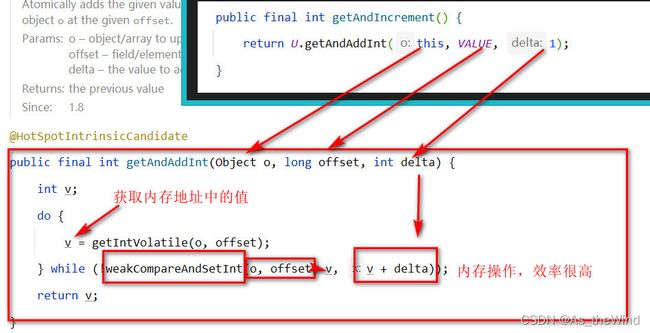
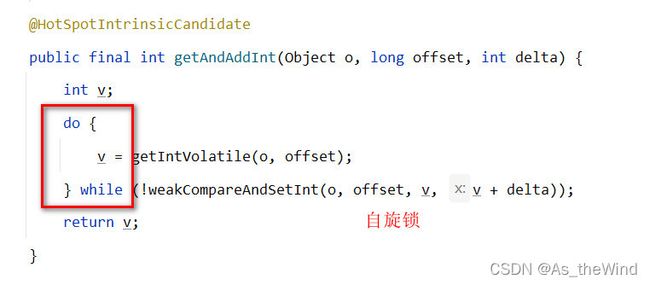
CAS:比较当前工作内存中的值和主内存中的值,如果这个值是期望的,那么则执行操作!如果不是就一直循环!
缺点:
1、循环会耗时
2、一次性只能保证一个共享变量的原子性
3、ABA问题
CAS:ABA问题(狸猫换太子)
import java.util.concurrent.atomic.AtomicInteger;
public class CASDemo {
//CAS compareAndSet:比较并交换
public static void main(String[] args) {
AtomicInteger atomicInteger = new AtomicInteger(2020);
//期望,更新
//public final boolean compareAndSet(int expectedValue, int newValue)
//如果我期望的值达到了,那么就更新,否则就不更新
// ==============捣乱的线程======
System.out.println(atomicInteger.compareAndSet(2020, 2021));
System.out.println(atomicInteger.get());
System.out.println(atomicInteger.compareAndSet(2021, 2020));
System.out.println(atomicInteger.get());
// ==============期望的线程======
System.out.println(atomicInteger.compareAndSet(2020, 6666 ));
System.out.println(atomicInteger.get());
}
}
20.原子引用
解决ABA问题,引入原子引用!对应的思想乐观锁
带版本号的操作 !
注意:
Integer使用了对象缓存机制,默认范围是-128~-127,推荐使用静态工厂方法valueOf获取对象实例,而不是new,因为valueOf使用缓存,而new一定会创建新的对象分配新的内存空间。

import java.util.concurrent.TimeUnit;
import java.util.concurrent.atomic.AtomicStampedReference;
public class CASDemo {
//CAS compareAndSet:比较并交换
public static void main(String[] args) {
// AtomicStampedReference 注意:如果泛型是一个包装类,注意对象的引用问题
// 正常在业务操作,这里比较的都是一个对象
AtomicStampedReference<Integer> atomicStampedReference = new AtomicStampedReference<>(1, 1);
new Thread(() -> {
int stamp = atomicStampedReference.getStamp(); //获得版本号
System.out.println("a1 =>" + stamp);
try {
TimeUnit.SECONDS.sleep(2);
} catch (InterruptedException e) {
e.printStackTrace();
}
System.out.println(atomicStampedReference.compareAndSet(1, 2,
atomicStampedReference.getStamp(), atomicStampedReference.getStamp() + 1));
System.out.println("a2 =>" + atomicStampedReference.getStamp());
System.out.println(atomicStampedReference.compareAndSet(2, 1,
atomicStampedReference.getStamp(), atomicStampedReference.getStamp() + 1));
System.out.println("a3 =>" + atomicStampedReference.getStamp());
}, "a").start();
//乐观锁的原理相同
new Thread(() -> {
int stamp = atomicStampedReference.getStamp(); //获得版本号
System.out.println("b1 =>" + stamp);
try {
TimeUnit.SECONDS.sleep(2);
} catch (InterruptedException e) {
e.printStackTrace();
}
System.out.println(atomicStampedReference.compareAndSet(1, 6, stamp,
stamp + 1));
System.out.println("b2 =>" + atomicStampedReference.getStamp());
}, "b").start();
}
}
21.各种锁的理解
1.公平锁、非公平锁
公平锁:非常公平,不能插队,必须先来后到!
非公平锁:非常不公平,可以插队,可以插队(默认都是非公平的)
public ReentrantLock() {
sync = new NonfairSync();
}
public ReentrantLock(boolean fair) {
sync = fair ? new FairSync() : new NonfairSync();
}
2.可重入锁
syschronized
//Syschronized
public class Demo01 {
public static void main(String[] args) {
Phone phone = new Phone();
new Thread(() -> {
phone.sms();
}, "A").start();
new Thread(() -> {
phone.sms();
}, "B").start();
}
}
class Phone {
public synchronized void sms() {
System.out.println(Thread.currentThread().getName() + "sms");
call(); //这里也有锁
}
public synchronized void call() {
System.out.println(Thread.currentThread().getName() + "Call");
}
}
Lock版
import java.util.concurrent.locks.Lock;
import java.util.concurrent.locks.ReentrantLock;
public class Demo02 {
public static void main(String[] args) {
Phone2 phone = new Phone2();
new Thread(() -> {
phone.sms();
}, "A").start();
new Thread(() -> {
phone.sms();
}, "B").start();
}
}
class Phone2 {
Lock lock = new ReentrantLock();
public void sms() {
try {
lock.lock(); //细节问题:lock.lock(); lock.unlock();
// lock 锁必须配对 ,否则就会死在里面
System.out.println(Thread.currentThread().getName() + "sms");
call(); //这里也有锁
} catch (Exception e) {
e.printStackTrace();
} finally {
lock.unlock();
}
}
public void call() {
try {
lock.lock();
System.out.println(Thread.currentThread().getName() + "Call");
} catch (Exception e) {
e.printStackTrace();
} finally {
lock.unlock();
}
}
}
3.自旋锁
import java.util.concurrent.atomic.AtomicReference;
//自旋锁
public class SpinlockDemo {
//int 0
//Thread null
AtomicReference<Thread> atomicReference = new AtomicReference<>();
//加锁
public void myLock() {
Thread thread = Thread.currentThread();
System.out.println(Thread.currentThread().getName() + "=> mylock");
//自旋锁
while (!atomicReference.compareAndSet(null, thread)) {
}
}
//解锁
public void myUnLock() {
Thread thread = Thread.currentThread();
System.out.println(Thread.currentThread().getName() + "=> myUnlock");
atomicReference.compareAndSet(thread, null);
}
}
测试
import java.util.concurrent.TimeUnit;
import java.util.concurrent.locks.ReentrantLock;
public class TestSpinLock {
public static void main(String[] args) throws InterruptedException {
/* ReentrantLock reentrantLock = new ReentrantLock();
reentrantLock.lock();
reentrantLock.unlock();*/
//底层使用的自旋锁CAS
SpinlockDemo lock = new SpinlockDemo();
new Thread(() -> {
lock.myLock();
try {
TimeUnit.SECONDS.sleep(5);
} catch (Exception e) {
e.printStackTrace();
} finally {
lock.myUnLock();
}
}, "T1").start();
TimeUnit.SECONDS.sleep(1);
new Thread(() -> {
lock.myLock();
try {
TimeUnit.SECONDS.sleep(1);
} catch (Exception e) {
e.printStackTrace();
} finally {
lock.myUnLock();
}
}, "T2").start();
}
}
4.死锁
死锁是什么
死锁测试,怎么排除死锁:
import java.util.concurrent.TimeUnit;
public class DeadLockDemo {
public static void main(String[] args) {
String lockA = "lockA";
String lockB = "lockB";
new Thread(new MyThread(lockA, lockB),"T1").start();
new Thread(new MyThread(lockB, lockA),"T2").start();
}
}
class MyThread implements Runnable {
private String lockA;
private String lockB;
public MyThread(String lockA, String lockB) {
this.lockA = lockA;
this.lockB = lockB;
}
@Override
public void run() {
synchronized (lockA) {
System.out.println(Thread.currentThread().getName() + "lock:" + lockA + "get " + lockB);
try {
TimeUnit.SECONDS.sleep(2);
} catch (InterruptedException e) {
e.printStackTrace();
}
synchronized (lockB) {
System.out.println(Thread.currentThread().getName() + "lock:" + lockB + "get " + lockA);
}
}
}
}
解决问题



